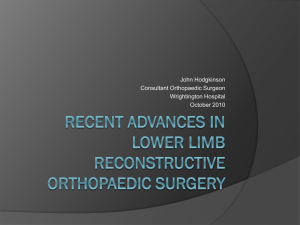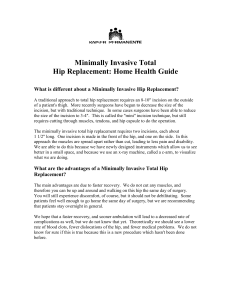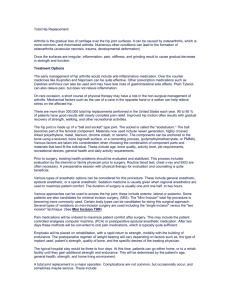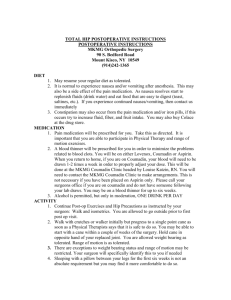Risks and complications
advertisement
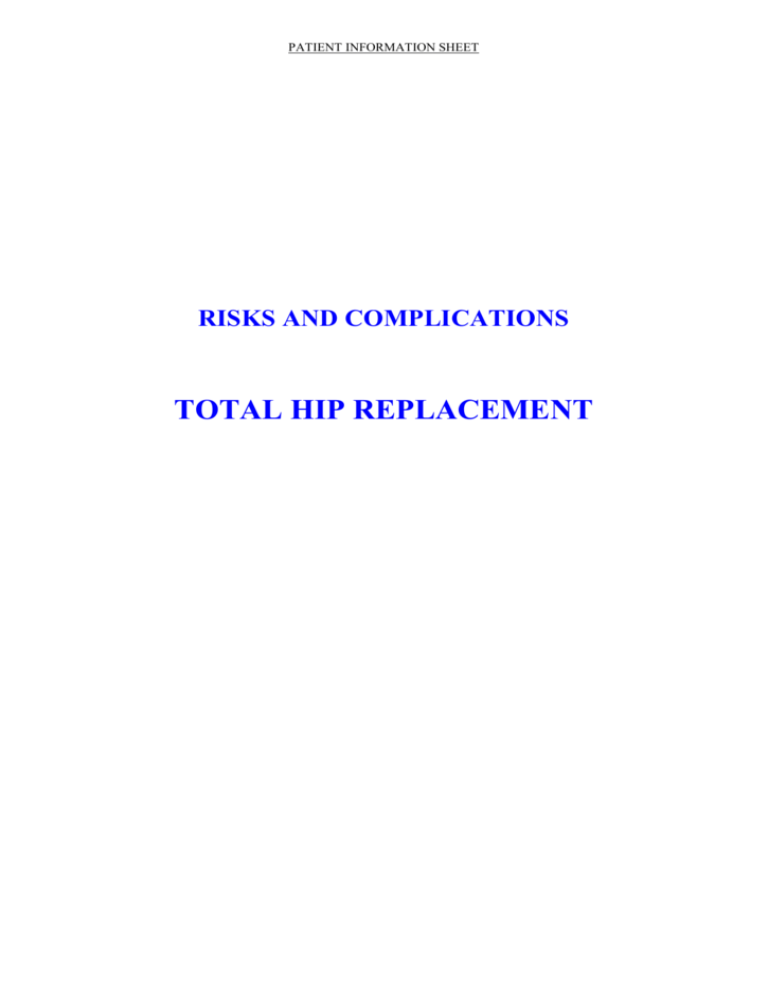
PATIENT INFORMATION SHEET RISKS AND COMPLICATIONS TOTAL HIP REPLACEMENT RISKS AND COMPLICATIONS - TOTAL HIP REPLACEMENT Index Pages INTRODCUTION 3 (1) ANAESTHETIC AND MEDICAL: 3 (2) BLOOD TRANSFUSION: 4 (3) INFECTION: 4-5 1. Superficial Wound Infection 2. Deep Infection (4) WOUND AND LEG PROBLEMS: 5-7 1. Wound Haematoma: 2. Tender Scar and Trochanteric Bursitis: 3. Leg Swelling: 4. Groin Aches: 5. Limp: 6. Leg Length Difference: 7. Referred pain: (5) DISLOCATION: 7 (6) OTHER COMPLICATIONS: 8-9 1. Allergies 2. Chest Infection: 3. Urinary Retention: 4. Fracture: 5. Nerve and Artery damage: (6) HOW LONG WILL MY HIP REPLACEMENT LAST: 9 CONCLUSION: 9-10 Further Information:- 10 2 PATIENT INFORMATION SHEET POTENTIAL RISKS AND COMPLICATIONS TOTAL HIP REPLACEMENT This sheet provides you with information concerning the most important risks and complications associated with having a total hip replacement. INTRODUCTION A hip replacement is an extremely successful operation. At least 95% of patients are satisfied with their new hip. It is very effective in getting rid of the pain experienced as a result of osteoarthritis or other degenerative hip problems. It improves the range of hip movement and allows you to return to a nearly normal level of activity. As with anything in life there is always a possibility of problems or unexpected events occurring. For example, even crossing the road or a car journey has inherent risks but this does not deter you providing you take reasonable precautions. This is also true of any major operation such as hip replacement. The list of risks provided here is not intended to frighten you, but for your information. It covers most of the problems, both major and minor, but it is not comprehensive. (1) ANAESTHETIC AND MEDICAL The type of anaesthetic needed for a hip replacement may be either a general anaesthetic, an epidural or spinal anaesthetic (an injection into or around the spinal canal) and / or a nerve block (to numb the nerves around the hip). For further information on this please print out the ‘Information Sheet – Anaesthetics’ 3 Any anaesthetic and major operation carries a very small increased risk of being complicated by the following medical conditions:1. a Heart Attack 2. a Stroke 3. a Deep Vein Thrombosis (blood clot in the leg) 4. a Pulmonary Embolus (blood clot in the lung) We will make sure you are medically fit for your operation and measures will be used to reduce the risk of blood clots occurring. (2) BLOOD TRANSFUSION During and after the operation you will lose some blood. The blood you lose will usually be made up by your own body in the weeks after surgery. A blood transfusion is rarely necessary these days. Blood needed for a transfusion is always tested and matched to your own but still carries very small risks associated with it such as :- 1. Rejection and reaction to the donor blood 2. Transmission of infection (3) INFECTION An infection can occur after any operation but it is particularly important that you understand its consequences when undergoing a total hip replacement. Precautions are taken before the operation to prevent an infection including nasal swabs and ensuring that there is no damage to your skin with cuts, wounds or infections. Prophylactic antibiotics (to reduce the risk of infection at the time of the surgery) are routinely used. 4 1. Superficial Wound Infection This is an infection of the healing wound where it is red and may have a small discharge. It is usually treated with a course of antibiotics but occasionally it may require a further small operation to help clear it. 2. Deep Infection There is a risk of an infection with bacteria getting around the hip replacement at the time it is inserted. The risk of a Deep Infection is about 1% (i.e.1 in every 100 cases). This is a very serious complication. If a deep infection occurs it may necessitate the hip replacement being removed so that the antibiotics can then work more effectively. This can mean a prolonged period in hospital before a further hip replacement is reinserted. Very occasionally a further hip replacement is not possible and we have to leave the patient without a hip replacement. These patients can normally walk short distances often without the use of crutches; a pronounced limp however is inevitable. This is called a “Girdlestone Procedure” and used to be the treatment for severe pain and arthritis before hip replacements were invented. (4) WOUND AND LEG PROBLEMS 1. Haematoma Bruising can develop around the wound and this can track down towards the knee. This is usually not a problem and will resolve over a few weeks. Occasionally a more significant bruise (haematoma) occurs under the wound and this can delay the healing. An operation may be required to release this blood collection. 5 This is more likely to happen if you are taking aspirin or anti-inflammatory medication (eg. Ibuprofen, Voltarol). Please inform us at the pre-assessment consultation if you taking this type of medication. Usually by stopping it for a week before your operation, the risk is reduced. 2. Tender Scar and Trochanteric Bursitis Some people have discomfort around their scar. Very occasionally it persists and is called trochanteric bursitis. Usually measures such as physiotherapy and time will help settle this problem. 3. Leg Swelling Leg swelling is quite common after the operation. It tends to improve each night with the rest and elevation. If it is worsening or becomes painful then you should seek advice as one of the causes of this swelling is a deep vein thrombosis. Usually there is no main underlying problem. The vast majority of this swelling settles over a 2 to 3 month period and does not cause any long-term problems 4. Groin Aches Minor aches and pains are usual. It must be remembered that the painful arthritic hip has not been used properly for a long time and your muscles are thus weak prior to the surgery. You will be exercising your new hip and most people experience some aches and pains for a few months while their muscle strength is building up again. 5. Limp This is common initially as your muscles recover from the surgery but improves and usually disappears once the muscles have regained their strength. Very occasionally a nerve is bruised or damaged and the limp will be permanent. The risk is dependant on the type of approach your surgeon makes to replace your hip but can be at least 1% (1 in 100 cases). 6. Leg Length Difference: Almost everybody, even if they do not have hip problems, has a slight different in our leg lengths. Although we try and ensure that your leg lengths are the same during the operation occasionally, for technical reasons, this is not possible. 6 Most people will initially feel that one leg is longer or shorter than the other after the operation. Contractures of the hip joint caused by the arthritis are released at surgery, thereby lengthening the leg back to normal. That feeling disappears within a few weeks. Even if there is a definite leg length difference, most people will tolerate a difference of up to ½ inch and over a period of a few months cease to notice it. Occasionally a small shoe raise is necessary after surgery if the feeling of a difference in the leg length is uncomfortable. 7. Referred pain If you have a back problem or a knee problem, as well as your hip problem, then pain from these two areas can be felt as if it is in the groin area. If you do experience any discomfort or pain in your hip or groin after the operation you should inform your surgeon or GP so that the cause of it can be investigated. (5) DISLOCATION: Risk of Dislocation - about 2-3% (2 to 3 in every 100 cases). A dislocation is when the ball of a hip replacement pops out of its joint. The risk is dependant on the type of approach your surgeon makes to replace your hip but can be at least 2-3%. A dislocation can occur at any time after your hip replacement but is most likely to occur during the first 6 weeks while all the muscles and tissues are healing. After the first 6 weeks the risk of dislocation is less likely. To prevent a dislocation you are given very specific instructions as to how you should move, sit and other do’s and don’ts. There are slight restrictions in terms of how you pick things up off the ground or reach your feet. The things you will not be able to do are squat down or bring your knees up to your chest. You need to follow these instructions very carefully. This is unlikely to restrict your activities significantly. In 7 general you will be able to undertake all normal activities apart from activities that give a lot of impact to the hip such as running. Ladies have to be generally more careful because socially they sit and pick things up in a slightly different way from men. They have to learn a different way of doing these activities. If you follow the guidelines then a dislocation is unlikely to occur. (6) OTHER COMPLICATIONS 1. Allergies If you are aware of an allergy to anything (causing swelling, a rash or difficulty breathing) please let us know at the pre-assessment consultation. Occasionally people have allergies to some of the medications (eg antibiotics) and material (eg metal) we use for the hip replacements. We test people for the common allergies such as iodine or Elastoplast. 2. Chest Infection: After any general anaesthetic there is a very small chance of developing a chest infection. This is usually treated with antibiotics and breathing exercises. 3. Urinary Retention: Some patients find they are unable to pass urine for several hours after having major surgery. If this occurs causing stretching of the bladder or pain then you may require the insertion of a catheter. In most cases we can then remove the catheter a day or two later once you are up and about. This is very rarely a problem in ladies. It is more common in men who have developed an enlarged prostate. If you feel you have symptoms such as having difficulty in passing water, especially having to get up frequently at night, please let us know before your operation. If necessary a referral to see a urologist will be arranged. 8 4. Fracture: Very occasionally during the operation the bone may break. The break will normally be fixed at the time of your surgery. Postoperatively you may be able to mobilize normally, but you may be asked to use crutches for a period of time. Very rarely the fracture may be treated with a period of bedrest. 5. Nerve and Artery damage: Very very rarely damage to a major nerve or artery can occur at the time of surgery. (7) HOW LONG WILL MY HIP REPLACEMENT LAST Research shows that up to 95% of hip replacements are lasting 10 years without problems. Hip replacements do not last forever. They have the potential to wear out as does any piece of mechanical machinery. If your hip replacement does wear out or becomes loose and painful it can be replaced in the vast majority of cases. This is called a revision hip replacement and is a much bigger and more difficult operation than the first hip replacement. There are many different types of Hip Replacement – For further information on this please print out the ‘Information Sheet – Types of Hip Replacement and Bearing Surfaces. CONCLUSION This is for your information to help you understand more about a hip replacement. It is certainly not intended to put you off having surgery or to unnecessarily worry or frighten you. In general a total hip replacement is an extremely successful pain-relieving, mobility restoring procedure. Many people who have total hip replacements return to a near normal life with very few restrictions. Sports including swimming, cycling, walking, doubles tennis are possible again. However patients need to be aware that occasionally things do not go quite as planned. In making up your mind that you wish to have the operation you must be aware of the risks so that 9 you balance them against the benefits of the operation. The time for a hip replacement is when for you, the benefit of the relief of your hip pain makes the potential risks acceptable to you. As stated at the beginning of this Information Sheet, this is not an absolutely comprehensive list of all the problems, but covers the vast majority that might be encountered following a total hip replacement. If you have any concerns or worries or would like further information about any of these problems or the ultimate success of the surgery please do not hesitate to ask your surgeon or a member of their team. Further Information:National Joint Registry (NJR) Website http://www.njrcentre.org.uk/ National Institute for Health and Clinical Excellence (NICE) Website http://www.niceguidance.org.uk/ NHS Website http://www.nhs.uk/ British Orthopaedic Association Website http://www.boa.ac.uk/ ARC Website http://www.arc.org.uk North Hampshire Hospitals NHS Trust www.northhampshire.nhs.uk 10

